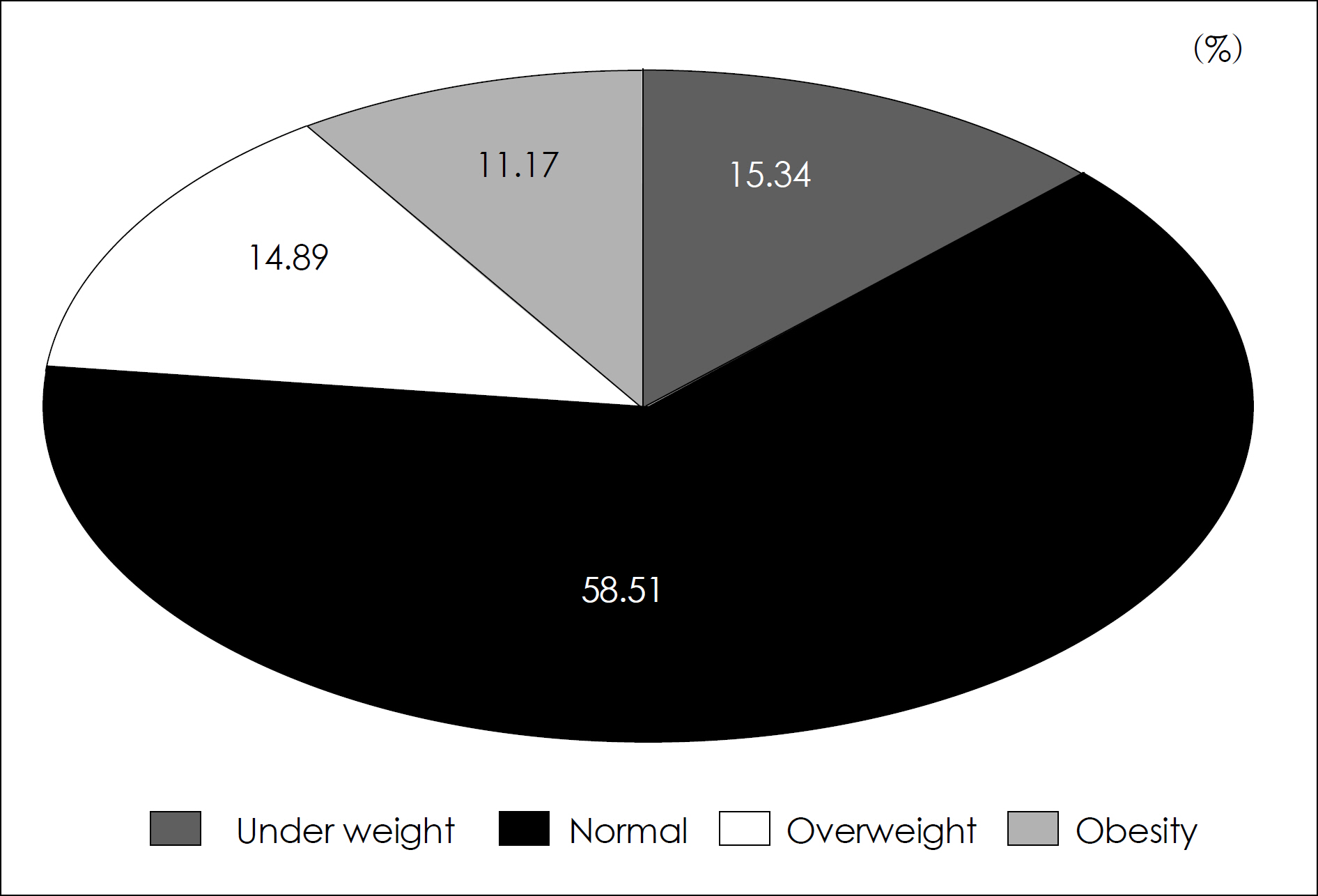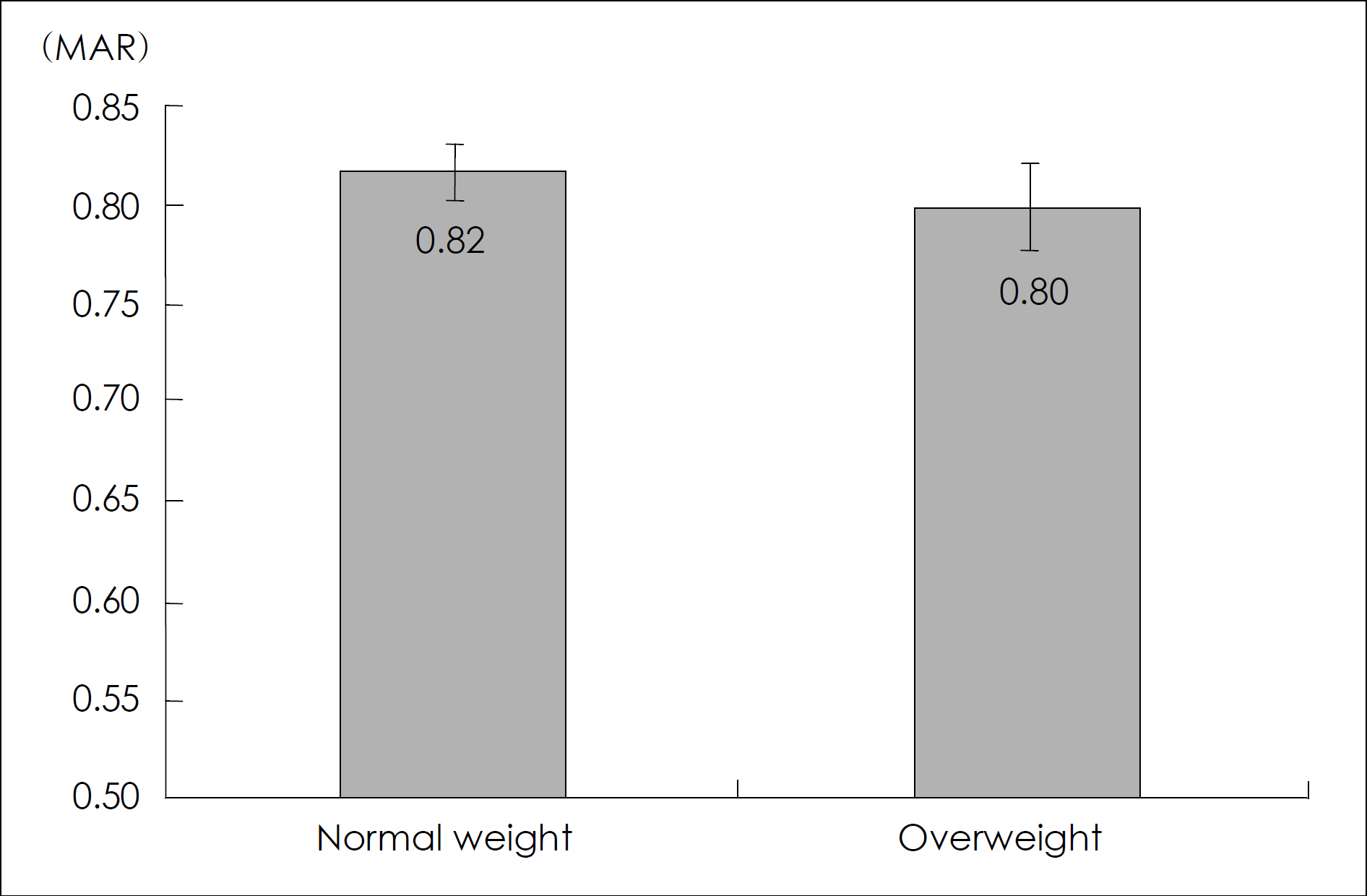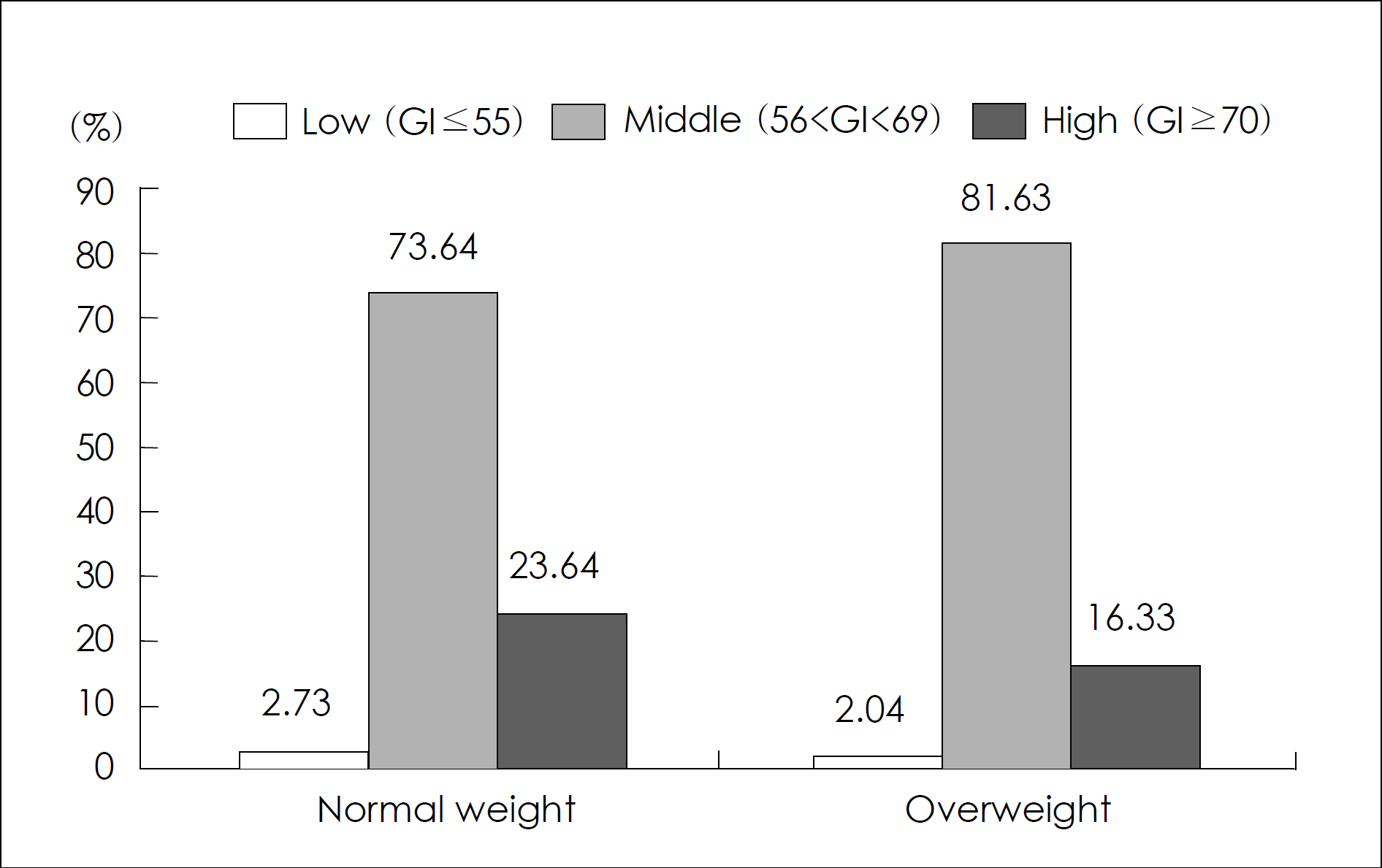Korean J Nutr.
2010 Oct;43(5):500-512. 10.4163/kjn.2010.43.5.500.
The Relationship between Food and Nutrient Intakes, Glycemic Index, Glycemic Load, and Body Mass Index among High School Girls in Seoul
- Affiliations
-
- 1Department of Food Service Management and Nutrition, Sangmyung University, Seoul 110-743, Korea. leejs1945@hanmail.net
- KMID: 2268047
- DOI: http://doi.org/10.4163/kjn.2010.43.5.500
Abstract
- investigated with high school girls residing in Seoul. As subjects, 159 girls were divided into a normal weight (NW) group (18.5 kg/m2 < or = BMI < 23 kg/m2, n = 110) and an overweight (OW) group (BMI > or = 23 kg/m2, n = 49) by body mass index (BMI). The food and nutrient intake data obtained by the 3-day food record were analyzed by Can pro 3.0 software. Anthropometric measurements were collected from each subject. Daily dietary GI (DGI) and dietary GL (DGL) were calculated from the 3-day food record. Body weights and BMI of NW were 52.4 kg and 20.4 kg/m2 and those of OW were 65.2 kg and 25.4 kg/m2, respectively. Total food, animal food, and other food intakes of NW were higher than those of OW, and vegetable food intakes of NW were lower than those of OW. Sugars intake of NW was significantly higher than OW. Nutrient intakes were not different between the two groups. Dietary fiber, calcium, and folate intakes of NW and OW were under 65% of the dietary reference intakes (DRIs). Major food sources of energy intake for both groups were rice, pizza, ice cream, pork, instant noodle, and chicken. Mean adequacy ratio (MAR), an index of overall dietary quality, was higher in NW (0.82) than in OW (0.80). Mean daily DGI of NW and OW was 66.5 and 66.4, respectively. Mean daily DGL of NW and OW was higher in NW (162.0) than in OW (155.9). DGI and DGL adjusted to energy intake were not significantly correlated with anthropometric data.
Keyword
MeSH Terms
Figure
Cited by 2 articles
-
Development of a Food Exchange Table and Food Pattern for Nutritionally Balanced Menu Planning
Yun Ahn, Ikhyun Yeo, Sangyun Lee, Kisun Nam
Korean J Community Nutr. 2018;23(5):411-423. doi: 10.5720/kjcn.2018.23.5.411.Utility of the Glycemic Index in Practical Diabetes Management
Jung Hwa Lee
J Korean Diabetes. 2015;16(2):135-140. doi: 10.4093/jkd.2015.16.2.135.
Reference
-
1). Lifshitz F, Tarum O, Smith MM. Nitrition in adolescence. In endocrinology and metabolism. Clinics of North America. 1993; 22(3):673–683.2). Kim YH. Kang YJ. Lee IS. Kim HS. Dietary fiber intake of middle school students in Chungbuk are and development of food frequency questionnaire. J Korean Soc Food Sci Nutr. 2010; 39(2):244–252.3). Lee KS. Kim JH, Mo SM. A study of ecology of food and nutrition among candidates of high school third graders for a university. J Korean Pub Health Assoc. 1990; 16(1):48–61.4). Chai HJ, Hong H, Kim HS, Lee JS, Yu CH. A study on food and nutrient intakes of weekday and weekend among high school boys in Seoul. Korean J Nutr. 2008; 41(6):539–549.5). Kim S, Moon S, Popkin BM. The nutrition transition in South Korea. Am J Clin Nutr. 2000; 71(1):44–53.
Article6). Ministry of Health and Welfare & Korea Center for Disease Control and Prevention. 2007 National health and nutrition examination survey report. Seoul. 2008.7). Kang YJ, Hong CH, Hong YJ. The prevalence of childhood and adolescent obesity over the last 18 years in Seoul area. Korean J Nutr. 1997; 30(7):832–839.8). Chai HJ, Hong H, Kim HS, Lee JS, Yu CH. Relationship between food intakes, glycemic index, glycemic load, and body weight among high school boys in Seoul. Korean J Nutr. 2008; 41(7):645–657.9). Koletzko B, de la Gueronniere V, Toschke AM, Kries R. Nutrition in children and adolescents in Europe: what is the scientific basis? Indroducation. Br J Nutr. 2004; 92(S2):S67–73.10). Ogden CL, Flegal KM, Carroll MD, Johnson CL. Prevalence and trends in overweight among US children and adolescents, 1999-2000. JAMA. 2002; 288(14):1728–1732.
Article11). Moses N, Mansour-Max B, Fima L. Fear of obesity among adolescent girls. Pediatrics. 1989; 83(3):393–397.
Article12). Lee MS, Sung CJ, Sung MK, Choi MK, Lee YS, Cho KO. A comparative study on food habits and nutritent intakes among high school students with different obesity indexes residing in Seoul and Kyunggi-do. Korean J Community Nutr. 2000; 5(2):141–151.13). Kim MH, Sung CJ, Lee YS. The study on Nutritional status of copper and zinc in Korean middle school female students according to body mass index. Journal of Korean Society for the Study of Obesity. 1999; 8(2):130–144.14). Park JK, Yim MJ. A study on the nutritional status and body mass index in Korean college women. Journal of Korean Society for the Study of Obesity. 2003; 12(1):24–29.15). Ministry for Health, Welfare and Family Affairs. The third korea na-tional health and nutrition examination survey (KNHANES III), 2005-Health status and health behaviors of children and adolescents. 2006.16). Ma YS, Olendzki B, Chiriboga D, Hebert JR, Le Yf, Li WJ, Campbell MJ, Gendreau K, Ockene IS. Association between dietary carbohydrates and body weight. Am J Epidemiol. 2005; 161:359–367.17). Lau C, Toft U, Tetens I, Richelsen B, J⊘rgensen T, Borch-John-sen K, Clümer C. Association between dietary glycemic index, glycemic load, and body mass index in the Inter99 study: is un-derreporting a problem? Am J Clin Nutr. 2006; 84:641.
Article18). Hui LL, Nelson EAS. Meal glycaemic load of normal-weight and overweight Hong Kong children. Eur J Clin Nutr. 2006; 60:220–227. -645.
Article19). Du H, Van der ADL, Feskens EJ. Dietary glycaemic index: a review of the physiological mechanisms and observed health impacts. Acta Cardiol. 2006; 61:383–397.20). Hare-Bruun H, Flint A, Heitmann BL. Glycemic index and glycemic load in relation to changes in body weight, body fat distribution, and body composition in adult Danes. Am J Clin Nutr. 2006; 84:871–879.
Article21). Davis JN, Alexander KE, Ventura EE, Kelly LA, Lane CJ, Byrd-Williams CE, Toledo-Corral CM, Robers CK, Spruijt-Metz D, Weigensberg MJ. Goran MI. Associations of dietary sugar and glycemic index with adiposity and insulin dynamics in overweight Latino youth. Am J Clin Nutr. 2007; 86:1331–1339.22). Kim CS, Hong HO, Lee JS, Kim JY, Maeng WJ. A study on nutrient intake status and food sources of iron by dietary iron density of high school girls in Seoul. Korean J Nutr. 2007; 40(4):371–384.24). The Korean Nutrition Society. Dietary Reference Intakes for Koreans. Seoul. 2005.25). Kang JH. Evaluation criteria of health body weight in Koreans-Focus on obesity. Korean J Community Nutr. 2001; 6(3):397–401.26). The Korean Nutrition Society. Can Pro 3.0 (nutritional analysis program). 2006.27). Lee RD, Nieman DC. Nutritional Assesment. 4th ed.New York: McGraw-Hill;2007.28). Foster-Powell K, Holt SHA, Brand-Miller JC. International table of glycemic index and glycemic load values: 2002. Am J Clin Nutr. 2002; 76:5–56.
Article29). Home of then glycemic index. http://www.glycemicindex.com/.30). NeoNutra GI center. http://www.gitest.co.kr/.31). Ahn HH, Kim JH, Song KH. A study on nutritional status and food habits according to obese index of high school girls in Seoul. Korean J Food & Nutr. 1996; 9(4):521–528.32). Lee HO, Lee YS. The study of relationship among body composition athletic ability and nutritional status of young women. Korean J Food & Nutr. 2005; 18(2):127–134.33). Chang HS, Kim MR. A study on the anthropometry and health-related lifestyle habits of women college students in Kunsan. Korean J Community Nutr. 2003; 8(4):526–537.34). Yu CH, Lee JS. A study on the nutritional status according to body mass index in Korean college women. Korean J Nutr. 2004; 37(10):899–907.35). Kim MH, Sung CJ, Lee YS. The study on nutrtional status of copper and zinc in Korean middle school female students according to body mass index. Journal of Korean Society for the Study of Obesity. 1999; 8(2):130–144.36). Lee YS, Park HS, Lee MS, Sung MK, Park DY, Choi MK, Kim MH, Sung CJ. A study of nutrient intake, serum lipid and leptin levels of elementary school students with different obesity index in Kyunggi area. Korean J Nutr. 2002; 35(7):743–753.37). Choi HJ, Seo JS. Nutrient intakes and obesity-related factors of obese children and the effect of nutrition education program. Korean J Community Nutr. 2003; 8(4):477–484.38). Wang SG. Prevalence of obesity, food habits, and daily nutrient intakes of 4th grade elementary school students in Daejeon. Korean J Human Ecol. 2007; 16(3):631–642.
Article39). Kim SH, Kim JY, Ryu KA, Sohn CM. Evaluation of the dietary diversity and nutrient intakes in obese adults. Korean J Community Nutr. 2007; 12(5):583–591.40). Jenkins DJ, Kendall CW, Augustin LS, Franceschi S, Hamidi M, Marchie A, Jenkins AL, Axelsen M. Glycemic index: Overview of implications in health and disease. Am J Clin Nutr. 2002; 76(suppl):S266–S273.
Article41). Kim K, Yun SH, Choi BY, Kim MK. Cross-sectional relationship between dietary carbohydrate, glycaemic index, glycaemic load and risk of the metabolic syndrome in a Korean population. Br J Nutr. 2008; 10:1–9.
Article43). Sahyoun NR, Anderson AL, Kanaya AM, Koh-banerjee PK, Kritchevsky SB, Rekeneire ND, Tylavsky FA, Schwartz AV, Lee JS, Harris TB. Dietrary glycemic index and load, measures of glucose metabolism and body fat distribution in older adults. Am J Clin Nutr. 2005; 82:545–552.44). Gaesser GA. Carbohydrate quantity and quality in relation to body mass index. J Am Diet Assoc. 2007; 107(10):1768–1780.
Article
- Full Text Links
- Actions
-
Cited
- CITED
-
- Close
- Share
- Similar articles
-
- Relationship between Food Intakes, Glycemic Index, Glycemic Load, and Body Weight among High School Boys in Seoul
- A Study of Glycemic Index, Glycemic Load and Food Sources according to Body Mass Index in Female College Students
- Utility of the Glycemic Index in Practical Diabetes Management
- Carbohydrate Consumption and Glycemic Index of the Usual Diet in Type 2 Diabetes Mellitus Patients
- Association between Glycemic Index, Glycemic Load, Dietary Carbohydrates and Diabetes from Korean National Health and Nutrition Examination Survey 2005






